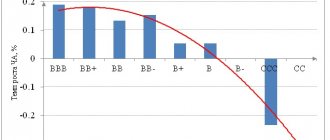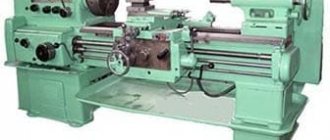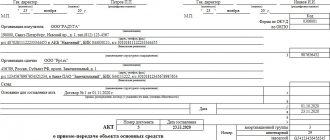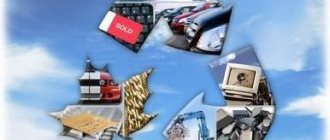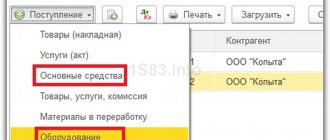Own working capital is an absolute indicator that is used to determine the liquidity of an enterprise. Essentially, this indicator determines how much the company's current assets are greater than its short-term debts. In foreign literature, own working capital is also called the working capital of an enterprise (working capital, net working capital).
Take our proprietary course on choosing stocks on the stock market → training course
Calculation of the indicator “own working capital”
Data on own working capital is formed on the basis of information contained in the balance sheet, which is the main source of information for analyzing the activities of the enterprise.
How the lines of the balance sheet are deciphered can be found in the article “Deciphering the lines of the balance sheet (1230, etc.).”
Various methods for analyzing the balance sheet of an enterprise are shown in the material “Methodology for analyzing the balance sheet of an enterprise.”
First of all, from the balance sheet you can obtain data on the assets and liabilities of the enterprise.
Enterprise assets are economic assets, control over which is obtained by the organization as a result of accomplished facts of economic activity and which should bring it economic benefits in the future.
Assets are divided into non-current and current, while own working capital is understood as that part of current assets that is financed from own sources.
Here is the formula for calculating our own working capital:
SOS = OA – KO,
Where:
SOS - own working capital;
OA - current assets;
KO - short-term liabilities.
Often the concept of “own working capital” is confused or considered synonymous with the concept of “own working capital”. Own working capital and own working capital have the same numerical value, but different economic meaning. If own working capital is part of the assets and resources aimed at making a profit, then equity capital is part of the long-term sources of financing through which own working capital is formed.
The formula for calculating your own working capital looks like this:
SOK = (SC + DO) – VA,
Where:
SOK - own working capital;
SK - equity capital;
DO - long-term liabilities;
VA - non-current assets.
The method for calculating your own working capital is quite simple, but at the same time you need to be able to interpret the obtained value and establish its relationship with other analytical indicators.
In the most general case, a positive value of own working capital is considered normal.
How the coefficient of provision with own working capital is calculated is shown in the article “Ratio of provision with own working capital”.
In practice, both an increase and a decrease in the value of this indicator can have different effects on the liquidity, financial stability and business activity of the enterprise. The composition of own working capital includes various assets: cash, accounts receivable, inventories. Changes in these components in dynamics and relative to each other can significantly change the structure of its own working capital and have a different impact on the financial position of the enterprise.
capital
Related publications
The organization's balance sheet presents many important financial indicators that characterize the company's business, including the cost of equity capital. At the moment, there are various ways to calculate such an indicator as equity capital - we will consider this below.
One of the main methods for calculating equity capital is based on the balance sheet data and is indicated in line 1300 “Total for section 3”. It consists of authorized capital, additional capital (also arising during the revaluation of fixed assets), reserve fund, as well as retained earnings.
In Russian legislation, the concept of equity capital often refers to net assets, which are formed from the balance sheet data by subtracting from the company’s assets (line 1600) all liabilities (lines 1400 and 1500), debts of participants and adding future income. This method helps participants and investors assess the value of a business.
There is also a method for determining equity for tax purposes when it comes to calculating income tax and there is controlled debt, that is, debt under a loan or credit when the person who issued the loan or security is a foreign company owning more than 20% of the borrower's share capital (directly or indirectly).
We must not forget that debt must exceed more than three times the amount of equity capital. For such borrowings, interest is not taken into account in expenses in full, but within certain limits (the “thin capitalization” rule). When we calculate equity capital for this case, then equity in the balance sheet is line 1300 “Total according to section. Ш" plus the borrower's tax debt.
I note that when it comes to tax arrears, this does not include arrears of contributions to funds (Pension Fund, Social Insurance Fund, Mandatory Health Insurance Fund).
Working capital turnover
The indicator of own working capital is directly related to the business activity of the enterprise.
The general indicator of business activity - the asset turnover ratio - is calculated as follows:
Ko = OR / SSA,
Where:
Ko - asset turnover ratio;
OR - sales volume for the analyzed period;
ASA is the average value of assets for the analyzed period.
In this case, the average value of assets is equal to half the sum of the value of assets at the beginning of the period and at the end of the period.
This coefficient characterizes the efficiency of resource use, regardless of the sources of their financing. It also shows how many times during the reporting period the full production cycle is completed and how many units of sold products in value terms are for each monetary unit of assets.
The turnover ratio does not have a standard value; it needs to be analyzed over time. If the turnover value decreases in dynamics, we can talk about inefficient use of assets, and vice versa, with its growth, the quality of asset management increases and the intensity of the enterprise’s activities increases.
It should be remembered that the asset turnover ratio is closely related to the industry of the enterprise. Trade enterprises will have a significantly higher turnover than capital-intensive industries.
The turnover ratio of current assets will be calculated as follows:
Kooa = OR / SSOA,
Where:
Kooa is the turnover ratio of current assets;
OR - sales volume for the analyzed period;
CCOA is the average value of current assets for the analyzed period.
This ratio gives an idea of the turnover of current assets and shows how much revenue from sales falls on each unit of current assets.
The duration of one revolution can be calculated as follows:
T = D / Ko,
Where:
T is the duration of the turnover period;
D is the number of days in the analyzed period;
Ko - turnover ratio.
To analyze business activity, you can evaluate the operating and financial cycles. To do this, the duration and nature of the organization’s net cash turnover period for the period is determined. This period is defined as the difference between the period of turnover of working capital involved in the operating cycle and the period of turnover of short-term liabilities:
ΔT = Toa – Tka,
Where
ΔT is the net period of cash turnover of the organization for the analyzed period;
Toa - period of turnover of working capital;
Tka is the period of turnover of short-term liabilities.
If the period of turnover of working capital is longer than the period of turnover of short-term liabilities, we can talk about a positive financial cycle. Otherwise, a negative financial cycle is formed.
If we consider the financial cycle indicator in relation to the indicator of own working capital, we can see that a positive financial cycle corresponds to the availability of own working capital, and a negative one is associated with a deficit of own working capital.
The most common mistake when analyzing SOS
Many accountants take the fixed asset coverage ratio as the SOS indicator. In fact, these are two completely different concepts. The coefficient cannot be used for a general assessment of economic activity; it only indicates the sufficiency or lack of own working capital necessary to cover the current expenses of the enterprise.
“The coverage ratio is a relative indicator that is used only to assess the current liquidity of an enterprise.”
entrepreneur, author of books and scientific articles on economics V. Yu. Zhdanov
The influence of own working capital on the financial performance of the enterprise
Analysis of working capital, their structure and turnover is necessary for making management decisions. With regard to working capital, management's goal is to increase their profitability and at the same time ensure financial stability and solvency. It should be remembered that increasing the profitability of working capital largely comes at the expense of financial stability.
With a constant indicator of own working capital, its structure may change; an increase in assets is associated with an outflow of cash, and vice versa, a decrease in assets leads to an increase in cash. If there is an increase in own working capital, then it occurs, as a rule, due to the growth of non-monetary assets - accounts receivable, inventories, which means that liquidity falls and current solvency decreases. If, nevertheless, growth occurs at the expense of cash, then along with the conclusion about the growth of liquidity and solvency, it should be noted that the organization may be using cash ineffectively, accumulating it in current accounts.
The growth of accounts receivable should always be compared with sales revenue. With revenue growth, it is natural for accounts receivable to increase, but if revenue falls or remains unchanged, and accounts receivable grows, then we can say that the organization is lending to its customers and is working ineffectively with accounts receivable.
Inventory increases should be assessed in terms of production necessity. Inventories include materials, goods in warehouses, finished goods, and work in progress. When analyzing the dynamics of materials, it is necessary to take into account the influence of their structure, seasonality factors, inflationary factors, and the specifics of working with suppliers. For work in progress, first of all, its rhythm is important. The balance of finished products and goods is influenced by the level of selling prices, product quality, and the structure of the sales market.
To increase financial stability, it is necessary to increase your own working capital. But if financial stability is achieved by financing current activities from more expensive sources compared to short-term sources of financing, then this will lead to a decrease in the capitalization of the enterprise.
Based on the analysis of your own working capital, you can decide on the choice of financing policy for the enterprise. For the purpose of analyzing and evaluating financing strategies, working capital is often divided into a permanent part and assets required due to seasonality of production, with seasonal growth in sales volumes. The permanent part of current assets is your own working capital. The constant need for assets of this group requires greater reliability in their financing, while the second group of working capital can be financed through short-term liabilities.
Analysis of own working capital can also be used to evaluate investment methods. If the amount of own working capital grows, this means that an increasing part of the assets is directed to generating income, and the organization loses profit, which means that investment cannot be considered effective.
Equity. Balance formula
Own capital consists of balance sheet liability items - authorized capital, share capital and contributions of partners (line 1310), additional capital (line 1350), reserve fund (line 1360), retained earnings (line 1730) and so on.
The formula for equity on the balance sheet is quite simple. Own capital in the balance sheet is line 1300 “Total” under section III “Capital and reserves”. For example, let’s find our own funds in the balance sheet of Soyuz LLC. Data as of December 31:
Results
It is advisable to analyze the company's own working capital in dynamics.
At the same time, it is necessary to study not only working capital, but also their structure. When making management decisions, it should be understood that the growth of own working capital leads to financial stability, but at the same time it is possible to reduce capitalization, divert part of the assets from circulation and reduce the turnover of working capital, reducing the efficiency of their use. You can find more complete information on the topic in ConsultantPlus. Free trial access to the system for 2 days.
Conclusion
If the SOS of an enterprise grows, then its financial stability increases, equity capital grows, and accounts payable decreases.
A decrease in the indicator indicates negative processes in the company’s financial activities and the need to take urgent measures to restore liquidity.
To date, this indicator is not mandatory when analyzing the structure of the balance sheet of enterprises. It is necessary for managers to obtain an objective result of assessing the company’s activities.

